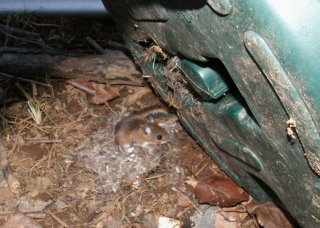I had almost dug out the rat snake when I remembered the large tree trunk above me. I was breaking away chunks of rotting wood in an effort to uncover the rat snake that Jen had spotted with her amazing eye for herpetological detail.
We were in South Carolina, in the eastern section of Francis Marion National Forest. We were down for a wedding in Charleston, and we decided to drive down and make a little vacation of it once we realized how expensive it would have been to fly to Charleston directly.
Anyhow, here is what Jen saw - the nose sticking out of this hole in the stump.
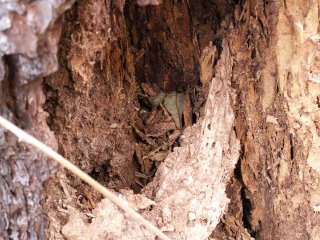
After some peering down in there, I decided it was a ‘greenish’ rat snake (Elaphe obsoleta obsoleta x quadrivittata), an intergrade between the black rat snakes (Elaphe o. obsoleta) that we have up here in the Northeast and the yellow rat snakes (Elaphe o. quadrivittata) that rule the southern coastal plain. The black rat snakes are usually solid black, the yellow rat snakes are yellow with black lines down their backs. When they mix in the wild the product is a dirty-green snake with thick black lines. These have a reputation for being ugly to look at and mean to handle.
I wanted to see more than the nose of this snake, but when it occurred to me that I was tearing away at the vertical support for this tree trunk (please excuse the smaller tree I somehow managed to catch in the foreground), I stopped.

We decided to go look around elsewhere and come back when the snake had had some time to calm down and come back out to bask. This is the view we found when we returned.

Jen rates this find second only to the scarlet king snake (Lampropeltis triangulum elapsoides) she found in Alabama four years ago.
Here are some other highlights of the trip:
This is another of the ambystomid salamanders, a Mole salamander (Ambystoma talpoideum). These are usually deep underground, so I was surprised to find it under a log.

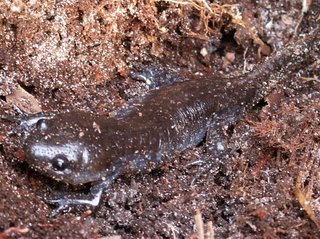
Here is a tiny ground skink (about three inches) we found elsewhere in the forest. These live in South Jersey too, but I’ve never found one there.

Here is a really special sight: a bunch of salamander larvae (each about 1/4 inch) hatching out of an egg mass in this wet spot in a right-of-way. These eggs were laid by some salamander (perhaps a mole salamander) a few nights before.
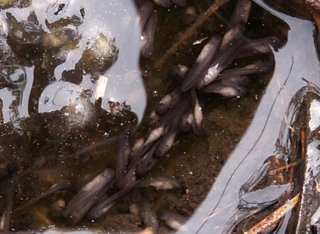
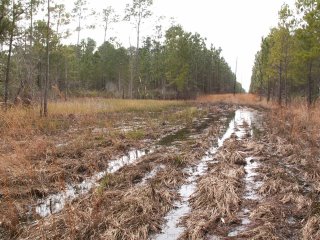
I scooped these tadpoles (each about one inch) out of one of those puddles. I don't know what kind of frog they'll grow into.
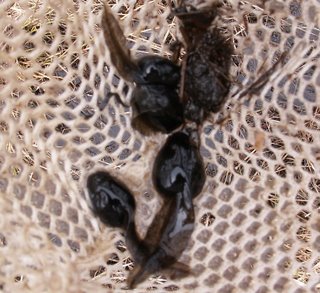
Last, here are some pictures of green anoles (Anolis carolinensis) that we found in the national forest. These guys are as common as the brown anoles (Anolis sagrei) are in Florida, and their abundance in a brown anole-free place makes me reconsider my thinking that the brown anoles are pretty benign in Florida. In Florida you only see the green anoles up in trees, while the broan anoles rule the ground and low vegetation. Since the green anoles were so common everywhere in South Carolina (they were coming out of the woodwork!), I have to conclude that the brown anoles are pushing them out of part of their natural habitat in Florida.
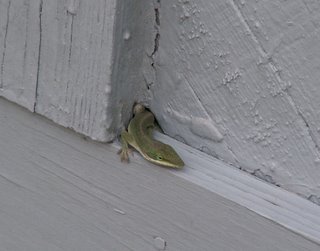
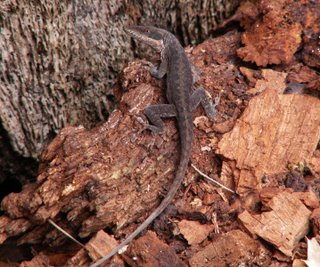
Here's an interesting anole behavior we saw close to Myrtle Beach. Anoles sleep on twigs at night, and here is one getting ready to go to sleep a little early (around 5:30 pm). It was still light out, but when I got close the little guy did not jump but just hugged tightly to his twig.

This is either a young southeastern five-lined skink (Eumeces inexpectatus) or broad-headed skink (Eumeces laticeps) that we found near Myrtle Beach. They look about the same, and this one was too small and squirmy for me to feel like counting scales to be sure of the identification.
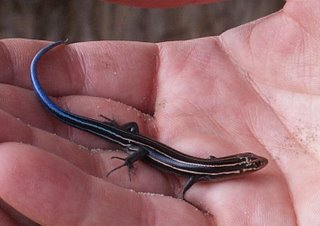
Last, here is a slimy salamander (Plethodon glutinosis) that Jen nabbed.

We found the skink and the anole on the twig near Myrtle Beach on March 9. The temperature was about 65 degrees. It had been partly cloudy and relatively dry that day. In Francis Marion NF the temperatures were in the low 70s and the skies were partly cloudy.
Trip totals:
1 greenish rat snake
1 ? skink
>30 anoles
3 ground skinks
>20 basking turtles
>10 bronze frogs (Rana clamitans clamitans)
1 mole salamander
7 slimy salamanders
? spring peepers heard (Pseudoacris crucifer)
